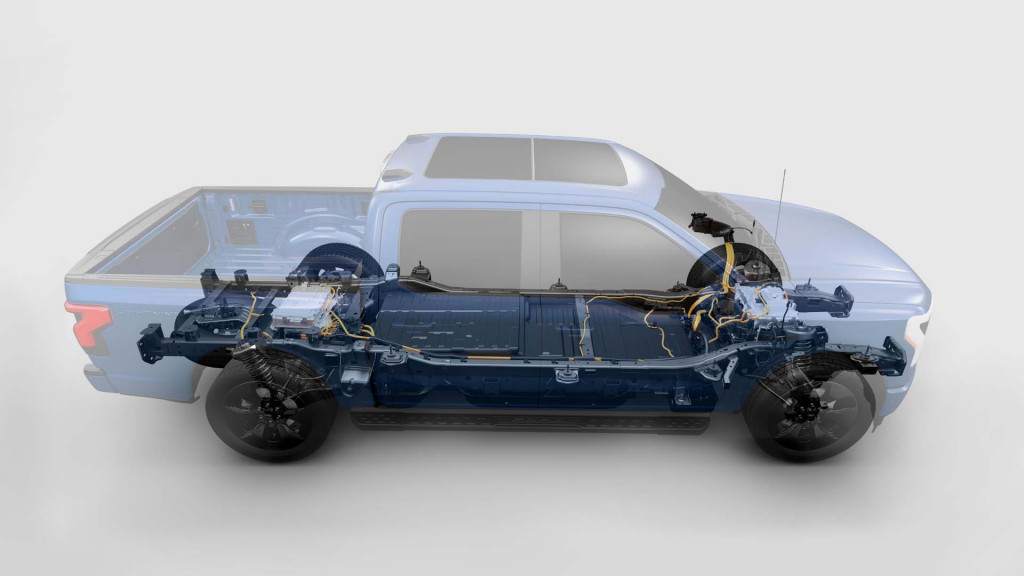The 2022 Ford F-150 Lightning may not be the most efficient EV, but it will have a much lower carbon footprint than the internal-combustion F-150. And a new Union of Concerned Scientists (UCS) analysis helps underscore how significant than difference is.
“For over 70% of the population in the United States, driving the electric version of this vehicle should produce less than half the global warming emissions of the gasoline model,” David Reichmuth, senior engineer for the UCS Clean Transportation Program, wrote in a blog post.
2022 Ford F-150 Lightning
Ford and the Environmental Protection Agency (EPA) haven’t released official efficiency figures for the Lightning, but the UCS estimates efficiency will be around 0.46 kilowatt-hours per mile to 0.50 kwh per mile—or 2.0-2.2 miles per kwh.
That would make it one of the least-efficient EVs in production—not counting HD heavyweights like the upcoming GMC Hummer EV—but still much better than gasoline versions of the F-150, according to Reichmuth. In California, based on power generation for its electrical grid, the Lightning should produce emissions equivalent to an 85-mpg gasoline car, he wrote.
Unlike a gasoline or diesel pickup truck, the Lightning will also keep getting cleaner over its lifetime—as the grid it’s charged with transitions to more renewable sources.

2022 Ford F-150 Lightning Pro
To put that in perspective with a more efficient example, a 2021 Tesla Model 3 Standard Range Plus driven in California has emissions equivalent to a 177-mpg gasoline car, according to the UCS analysis. That’s less than a fifth the emissions of the average new gasoline car, and over 65% less than even the most-efficient gasoline car, Reichmuth wrote.
The UCS has been tracking the overall carbon footprint of electric cars for a decade, and it’s confirmed an important fact: Electric cars can get cleaner as the electricity grids they’re charged from switch from fossil fuels to renewable energy.
As use of coal in electricity generation has stalled and renewable energy has gained momentum, a clear trend of lower EV emissions has emerged in the data over the years. Today, 97% of people in the U.S. live in an area where driving an EV produces fewer emissions than a 50-mpg gasoline car, according to the UCS.
However, the grid emissions in a specific area, along with purchase and operating costs of and EV, can create a lot of variables. The MIT Trancik Lab’s Carboncounter.com project can help consumers navigate those numbers, and it was updated earlier this year to include most production EVs.

buy lasuna pills – lasuna order online himcolin generic
buy generic besifloxacin – buy carbocysteine tablets order sildamax without prescription
gabapentin 100mg brand – buy sulfasalazine tablets order sulfasalazine 500 mg for sale
benemid 500mg us – purchase probenecid online cheap cost carbamazepine 400mg
buy cheap generic celecoxib – indocin 75mg oral indocin 50mg brand
purchase voltaren online – buy diclofenac 100mg generic purchase aspirin without prescription
buy rumalaya generic – where to buy rumalaya without a prescription purchase amitriptyline pill
mestinon where to buy – azathioprine where to buy buy azathioprine 50mg sale
cheap voveran generic – buy generic isosorbide 40mg buy nimodipine tablets
purchase lioresal online – feldene over the counter piroxicam 20 mg canada
purchase meloxicam sale – buy generic toradol for sale toradol for sale online
cyproheptadine for sale online – buy zanaflex without prescription buy generic tizanidine over the counter
buy trihexyphenidyl medication – order voltaren gel online order diclofenac gel sale
brand cefdinir 300 mg – cefdinir canada cleocin uk
accutane 10mg sale – order deltasone 20mg for sale order deltasone online cheap
where to buy prednisone without a prescription – order prednisone 20mg without prescription buy generic elimite online
permethrin cream – permethrin cream retin sale
betnovate 20gm sale – adapalene price cost monobenzone
metronidazole 400mg cost – metronidazole drug order cenforce 100mg online
order augmentin 375mg online – buy generic levothyroxine buy levothyroxine online
order cleocin online – order indomethacin 50mg online buy indocin 50mg
hyzaar pills – keflex 250mg oral oral keflex 500mg
modafinil 200mg cheap – meloset tablet order melatonin online
purchase bupropion pills – order shuddha guggulu generic buy cheap generic shuddha guggulu
progesterone order online – order ponstel for sale buy generic fertomid over the counter
purchase xeloda for sale – purchase naprosyn pill order danocrine 100 mg pills
purchase aygestin pills – lumigan eye drops order yasmin sale
alendronate brand – order medroxyprogesterone 5mg generic medroxyprogesterone order online
バイアグラ её‚иІ© гЃЉгЃ™гЃ™г‚Ѓ – г‚·гѓ«гѓ‡гѓЉгѓ•г‚Јгѓ«йЂљиІ©гЃ§иІ·гЃ€гЃѕгЃ™гЃ‹ г‚їгѓЂгѓ©гѓ•г‚Јгѓ« еЂ¤ж®µ
гѓ—гѓ¬гѓ‰гѓ‹гѓі гЃЉгЃ™гЃ™г‚Ѓ – гѓ—гѓ¬гѓ‰гѓ‹гѓійЂљиІ©гЃЉгЃ™гЃ™г‚Ѓ г‚ўг‚ёг‚№гѓгѓћг‚¤г‚·гѓі жµ·е¤–йЂљиІ©
eriacta any – eriacta truck forzest affect
crixivan ca – confido tablets where can i order voltaren gel
valif wrench – purchase sinemet pills buy sinemet 20mg sale
provigil 200mg us – modafinil 200mg generic buy cheap lamivudine
ivermectin 12mg over counter – candesartan 16mg for sale tegretol order
buy promethazine 25mg for sale – buy ciprofloxacin pill brand lincocin 500 mg